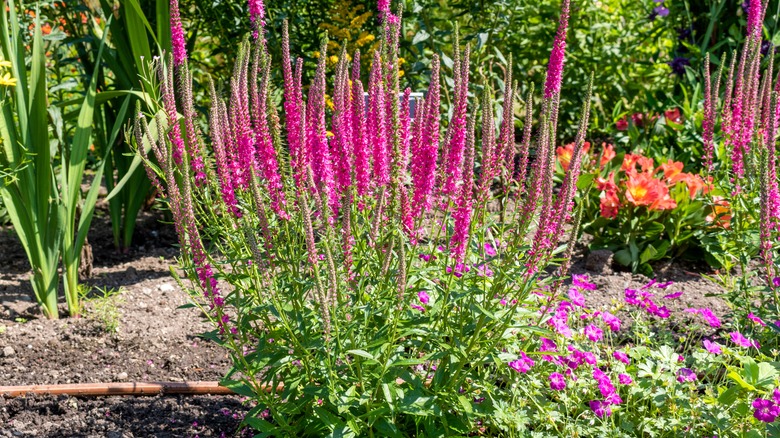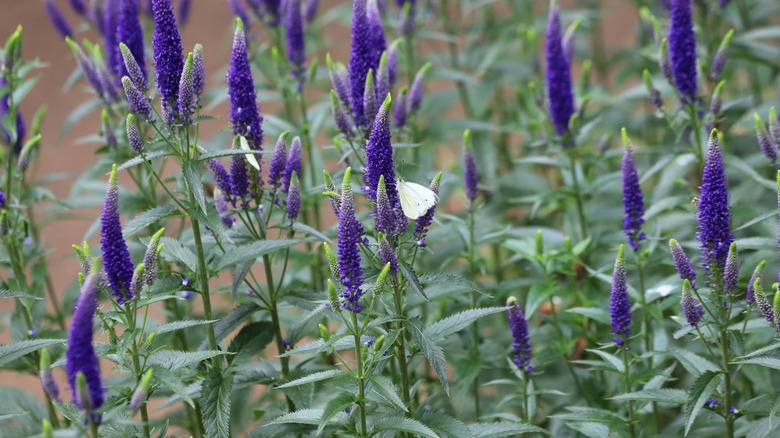This Non-Invasive Speedwell Flower Is Perfect For A Drought Tolerant Garden
If you're not growing weeds in your garden, maybe you should. Most gardeners have a general idea of what a weed looks like — spiky, unkempt, and aggressive — but the actual definition of a "weed" is just any plant that grows where it's not intended or desired. They say that beauty is in the eye of the beholder, and many common weeds have a certain appeal about them, admirable for their survival skills if nothing else. You might drive down the highway and gaze out the window at summer wildflowers blowing in the breeze, wondering how they survive such hot, dry, and windy conditions with no gardener around to care for them. And so many of these wild plants are gorgeous to boot! If you're a secret admirer of roadside wildflowers and other "weeds," spiked speedwell might but just the garden plant you're looking for.
You might be thinking, "Speedwell? Isn't that an invasive plant you should never grow?" It's true that some varieties of speedwell are highly invasive, but spiked speedwell (Veronica spicata) is totally safe for your garden and can add a nice pop of color in summer. Here's what you need to know about this hardy flowering plant, its benefits and uses, and how you can grow spiked speedwell in your garden.
Spiked speedwell offers low-maintenance summer blooms
There are more than 500 species in the Veronica genus, only a handful of which are used in gardening and landscaping. Veronica spicata, or spiked speedwell, is an herbaceous perennial with pale green, pointed leaves, tall stalks, and conical, pillar-like blooms with either pink or deep purple flowers. Hybrid varieties of Veronica spicata such as White Wands may also have pretty white flowers. This plant is native to coastal and mountainous regions of Europe and Asia, where it thrives amid the sun, rocks, and tumultuous weather conditions. Once established, spiked speedwell is hardy in USDA zones 3 through 8, and it requires very little maintenance from the gardener.
The mature plant can reach up to 3 feet tall and 2 feet wide, and is generally deer, rabbit, and pest resistant. Each year, this perennial plant should return with vibrant blooms in late spring through summer, making it one of the best colorful flowers that's perfect for summer border gardens. If you're worried about children or pets in the yard, spiked speedwell is considered non-toxic to humans, pets, and livestock, making it a safe plant to keep near playscapes and other common areas. However, it tends to attract bees, so little ones may need to use caution to avoid being stung.
Growing and caring for spiked speedwell
Choosing where to plant spiked speedwell may make some gardeners nervous, but there's no reason to fear this plant. This plant can grow somewhat quickly, but it won't take over your garden like its invasive cousins. Spiked speedwell grows in neat, tall clumps, so it can be treated much like a perennial shrub or ornamental grass when it comes to landscaping. As such, it's quite useful for filling in bare areas where nothing else seems to survive the hot summer sun, and it will quickly make itself at home in rock gardens and perennial beds. It can also be grown quite happily in raised beds and container gardens, as long as it receives enough sunlight.
Although it is drought tolerant, spiked speedwell prefers moist, well-draining soil, and needs about an inch of water per week until it is mature enough to handle drought. However, root rot can present a risk to these plants, so avoid overwatering, especially when sunlight is weak. If all goes well, this plant will produce beautiful blooms from late spring to mid-summer, but you can encourage re-blooming in the fall by cutting the plant down to its basal rosette after the first set of flowers have faded. Spiked speedwell blooms are very attractive to bees and butterflies, so its one of the best plants for your pollinator garden. The blossoms can also look gorgeous and last a long time when displayed in fresh-cut flower arrangements!


